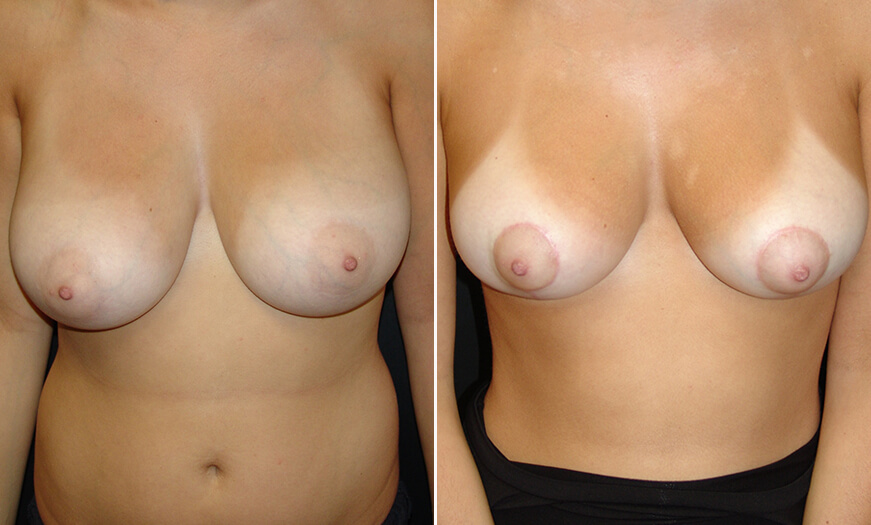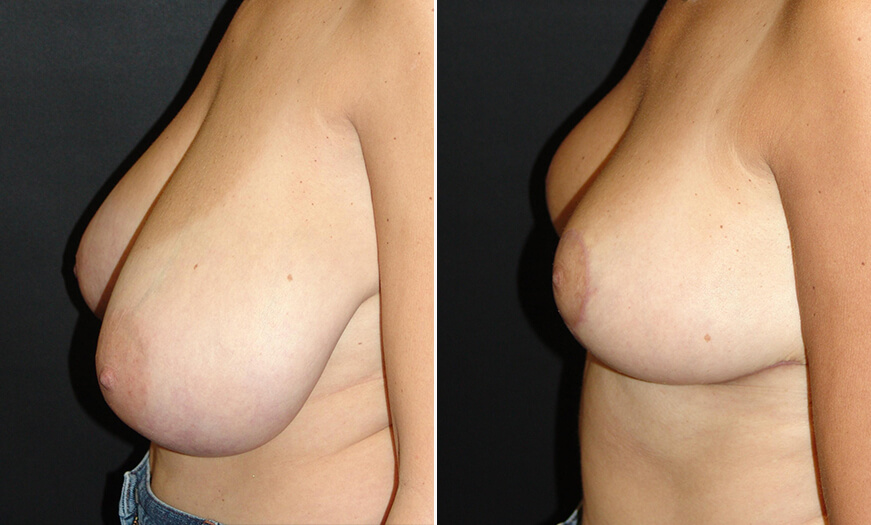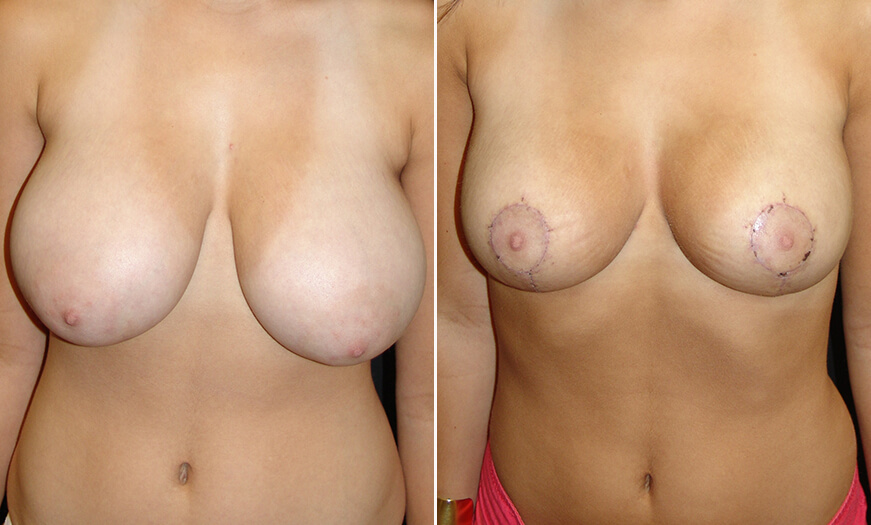

101 OLD SHORT HILLS RD, WEST ORANGE, NJ 07052
973.731.7000
620 PARK AVENUE, NEW YORK, NY 10065
212.938.0158
Breast Reduction New Jersey
Reduction Mammoplasty
Breast reduction can help women achieve a smaller breast size and shape and reposition the nipple for natural-looking breasts. Large breasts can make it difficult for a women to exercise or wear clothing that she likes. Larger breasts often contribute to chronic neck, back, and shoulder pain. Women may also be more prone to chafing or skin irritation if they have larger breasts. Overly large breasts can also hinder a woman’s daily activity and cause a woman to be unhappy with her appearance. At Asaadi Plastic Surgery, we can help you reduce the size of your breasts and create beautifully symmetrical results.
What Is Breast Reduction Surgery?
Breast reduction surgery, also known as reduction mammoplasty, is a procedure where excess breast fat and tissue are carefully removed through small incisions. After excess fat and tissue are removed from the breasts, any excess skin will also be removed to create youthful-looking, smaller breasts. Other than reducing the size of your breasts, breast reduction surgery can also help you achieve a natural-looking breast shape for the most pleasing results. The length of your breast reduction surgery depends on your individual case and the amount of excess breast fat and tissue being removed. Breast reduction is commonly performed through the pedicle technique.
While there are several variations of the pedicle technique, all pedicle breast reduction methods entail moving the nipple and areola higher up on the breast. The nipple and areola are attached to tissue that is called a pedicle, which is where the procedure gets its name from. The pedicle contains nerves, ducts, and a blood supply that will retain the functionality of your breast when it comes to breastfeeding. The pedicle technique varies depending on which part of the breast remains attached (above, below, or to the side of the areola). Preserving the circulation and sensation to the nipples during breast reduction surgery is of utmost importance. Venous congestion should be avoided. While the base of the pedicle does not need to be too wide, it should carry ample blood supply. Dr. Asaadi is very meticulous and pays close attention to the distance between the areola and inframammary line to compliment the patient’s height, weight, and breast size. Some patients choose to combine breast reduction surgery with a breast lift for lifted, youthful-looking breasts.
Breast Reduction Surgery Overview
| Step 1 | Dr. Asaadi thoroughly plans every detail of your breast reduction surgery and assessess every detail to customize breast reduction for your particular goals |
| Step 2 | You will be placed under anesthesia during your breast reduction so that you feel no discomfort |
| Step 3 | Discreet incisions will be made on the breasts where excess fat and tissue will be removed |
| Step 4 | Excess fat, tissue, and skin are carefully removed from the breasts, creating smaller, symmetrical breasts |
| Step 5 | The nipples and areolas will be properly repositioned higher for the most natural-looking results |
| Step 6 | Sutures will be applied to any incisions to ensure proper healing and to minimize the risk of scarring |
Many younger patients seek out breast reduction surgery. Reduction mammoplasty must be performed differently on a younger patient than an older patient. Younger patients often heal quicker with virtually little to no scarring. Younger women are often more concerned with perfectly shaped breasts and reducing the possibility of scarring. Breast reduction surgery should be performed with great detail so that no future augmentation is required. Dr. Asaadi goes to great lengths to ensure that every detail, no matter how small, is looked at to guarantee optimal breast reduction outcomes.
What Can I Expect Before My Breast Reduction Surgery?
A breast reduction consultation will begin with an examination of your breasts to determine what surgical technique is most appropriate. During your consultation, details about your particular breast reduction surgery will be discussed, such as where incisions will be placed and the amount of breast fat to be removed. Dr. Asaadi will also check your medical history and general medical health to ensure your wellbeing during breast reduction surgery. Ideal breast reduction candidates are looking to reduce the size of their breasts while achieving a more balanced, natural appearance.
Prior to your reduction mammoplasty, certain blood-thinning medications such as aspirin should be stopped. Dr. Asaadi can determine which medications should be stopped leading up to your breast reduction surgery. On the day of your surgery, you should wear loose-fitting, comfortable clothing with no jewelry or makeup. You should have a friend or family member accompany you to your reduction mammoplasty surgery, as you will be unable to drive following your procedure. We also recommend that you have someone stay with you for the first few days after your breast reduction surgery.
What Can I Expect After My Breast Reduction Surgery?
After your breast reduction surgery, drains may be placed to remove any excess fluid from your breasts to promote proper healing. Your breasts will be gently wrapped after breast reduction surgery, and this wrap will need to be changed 1-2 days after your reduction mammoplasty. You may also be given a support garment that you will wear after your breast reduction procedure. A support garment reduces the risk of hurting your healing breasts and can gently support them during your recovery. Support bras are often worn for the first few weeks after your breast reduction surgery to reduce any possibility of discomfort.
Your breasts may be sore after breast reduction surgery, and you may experience slight bruising, swelling, and discomfort. Breast reduction side effects vary depending on the extent of your surgery and if you have combined breast reduction surgery with another procedure, such as a breast lift. Your recovery period will also be affected by if you have drains placed in your breasts or not. Any stitches from your reduction mammoplasty surgery will be removed 1-2 weeks following your surgery.
You will not be able to bend or lift objects following your breast reduction surgery. You also may not workout, play sports, or partake in any strenuous activity for at least 1 month following your breast reduction procedure. Any pain, bruising, or swelling should fade in the days and weeks following your reduction mammoplasty. Dr. Asaadi can also prescribe oral medication to reduce any pain or discomfort you may feel. As you continue to heal, you will being to notice that your breasts are smaller, symmetrical, and natural-looking.



The Importance Of Choosing A Highly Experienced Breast Reduction Surgeon
It is important that you choose a skilled breast reduction surgeon who understands your individual anatomy. When the right plastic surgeon performs breast reduction surgery, there is usually no need for a revision. Dr. Asaadi stresses the importance of choosing a qualified, experienced, and board-certified plastic surgeon when considering breast reduction.
How Can I Get Started With Breast Reduction Surgery?
Dr. Mokhtar Asaadi and our staff will be happy to discuss breast reduction with you. Please contact our New Jersey office at 973.731.7000 or our New York office at 212.938.0158 to schedule a private consultation. You may also request an appointment online to meet with our breast reduction surgeon.


